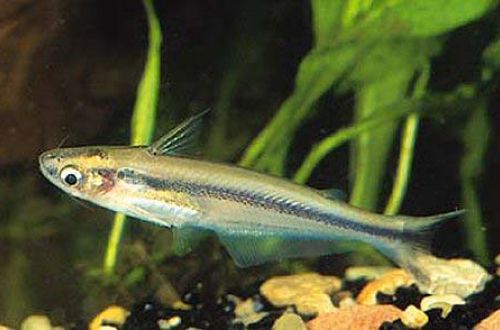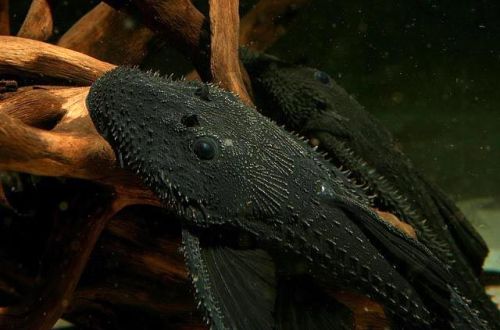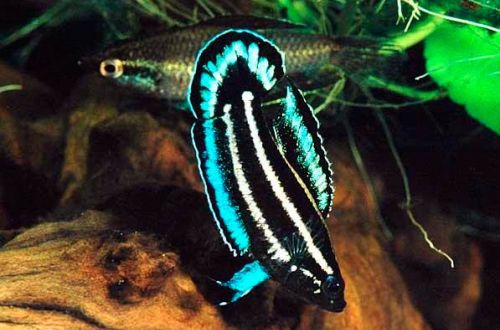
African glass catfish
The African glass catfish, scientific name Pareutropius debauwi, belongs to the Schilbeidae family. A peaceful, easy-to-keep schooling fish. It does not have a bright color, therefore it is considered as an addition to the freshwater aquarium community.

Contents
Habitat
It comes from the equatorial part of Africa. The natural habitat extends over a large part of the Congo Basin. Occurs mainly in areas of rivers with dense aquatic vegetation.
Brief information:
- The volume of the aquarium – from 100 liters.
- Temperature – 24-28°C
- Value pH — 6.0–7.5
- Water hardness – soft or medium hard (5-15 dGH)
- Substrate type – any dark
- Lighting – subdued or moderate
- Brackish water – no
- Water movement – light or moderate
- The size of the fish is 8–10 cm.
- Food – any sinking food
- Temperament – peaceful
- Content in a group of at least 6–8 individuals
Description
Adult individuals reach a length of up to 8–10 cm. Outwardly, the fish is not too similar to classic catfish, which is explained by its lifestyle. The African glass catfish is an active swimmer and spends most of its time in the water column, and not at the bottom.
The body is silvery with a black stripe running from head to tail. Fins are translucent. It is often confused with another closely related species, the Striped Glass Catfish. The latter can be distinguished by three black stripes on the body and dark spots on the tail. At a young age, both species are almost identical.
African and Striped glass catfish
 Visual differences between two closely related species, the African glass catfish and the striped glass catfish
Visual differences between two closely related species, the African glass catfish and the striped glass catfish
Sexual dimorphism is weakly expressed, males and females are practically indistinguishable from each other.
Food
In a home aquarium, it will accept most popular sinking foods (flakes, granules). Live or frozen brine shrimp, bloodworms and other invertebrates of a suitable size are a good addition to your daily diet.
Maintenance and care, arrangement of the aquarium
The optimal size of an aquarium for a flock of 6-8 fish starts from 100-150 liters. The design should include areas with dense vegetation and open areas for swimming. The presence of floating plants, snags at the bottom is welcome. Any dark soil.
Fish prefer soft slightly acidic water. It is acceptable to slightly exceed the pH and dGH values above neutral and up to the level of medium hardness. Any changes should occur smoothly, without sudden jumps.
Successful long-term management depends on maintaining a stable habitat in mild, slightly acidic water conditions. We must not allow excessive accumulation of organic waste that can disrupt the normal flow of the nitrogen cycle.
Behavior and Compatibility
Flock look. A prerequisite is to be in a group of at least 6 individuals. Alone African glass catfish become fearful, seek to hide, experience constant stress and may refuse food. Peaceful, compatible with other West African fish of comparable size.
Breeding / breeding
Under certain conditions, breeding is quite possible. A high-protein diet and keeping in slightly acidic water (6.5–7.0 pH) at a temperature of about 26–27°C promotes the start of spawning. Females scatter their eggs among thickets of small-leaved plants such as Java moss. One female is capable of carrying up to 100 eggs, but only a fraction of them will be fertilized. The incubation period lasts about 72 hours. At first, the fry feed on the remains of their yolk sac and only then begin to search for food.
For the convenience of feeding and protecting the offspring from predation by adult fish, they are transplanted into a separate tank, or they are bred in a spawning aquarium.
Artemia nauplii or special feeds in the form of suspensions and powders intended for feeding fry can be used as the first food.
Fish diseases
Under favorable conditions, the risks to fish health are negligible. As a rule, diseases in aquariums are the result of improper maintenance, so the best protection against disease is timely maintenance, quality food and the absence of threats in the form of aggressive fish.
If symptoms of a particular disease are noted, then first of all it is worth paying attention to the conditions of detention and only then proceed to treatment. Read more in the section “Diseases of aquarium fish”.





